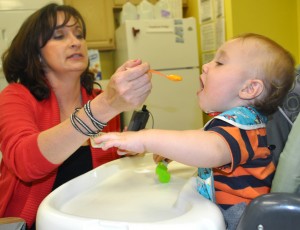Over Three Less-Than-Amazing Ways to Show a Picky Eater That Eating Can Be Fun

From an amazing speech-language pathologist who treats children with feeding issues
I recently interviewed Christie Olguin, CCC-SLP (Certificate of Clinical Competence in Speech-Language Pathology) and clinic director at ABILITY Pediatric Therapy in San Antonio.
Leading over 100 therapists, Christie personally works mainly with kids with food aversion. She’s helped many severe cases overcome problem eating.
One idea that this expert in solving picky eating made clear to me is that enjoyment matters! Enjoyment is essential! Enjoyment in eating is healthy. It’s not a luxury or a frivolous frill. It’s not an indulgent distraction from the dread duty of getting used to eating what’s good for you. Pleasure in eating may be the most important lesson to teach a picky eater.
That day, Christie was working with an 11-month-old, Grant, who is averse to food. Grant is food averse for several reasons.
Grant learned early that eating meant pain from acid reflux. He was diagnosed with a severe milk allergy and dysphagia (difficulties in swallowing). Eating was a dangerous proposition for him from the start. Painful, scary experiences led to aversion, like they do for anybody. Pressuring him to eat would only increase his fear and dread.
Grant is now gradually learning that eating can be enjoyable.
You can’t tell looking at him that he has any problems at all; he’s roly-poly and grinning. I can imagine, though, that such a child could have died in the old days. Today, plenty of brilliant solutions have been developed to help him, and are available at clinics like ABILITY Pediatric Therapy.

Therapy exists for a variety of feeding problems. Here, Grant has electrical stimulators on his throat to improve his ability to swallow safely and comfortably. Christie Olguin, CCC-SLP, of ABILITY Pediatric Therapy, is his therapist. – photo by Anna Migeon
But parents don’t need training as a therapist to provide the experience of enjoyment in eating for their children, picky or problem feeder or not.
Christie shared several ideas with me that can help any parent who wants to help a child who’s had bad experiences with eating.
These “rules” are really just normal parenting, I’m afraid. They may not seem terribly earth-shaking. They are the same things parents of non-picky children should do.
1. All children, especially picky ones, need good old-fashioned mealtime routines.
- Mealtimes need to be family times: Kids with problems need to be included socially, whether they eat or not. Meal times should be enjoyable and pleasant. If they’re not, that’s the first change to make.
- Scheduling is key: Even for a newborn who’s not eating well, it helps to work toward set meal times, instead of chaotic, unscheduled feeding. Parents of a child who’s diagnosed with failure to thrive often have a hard time ever saying no when that child asks to eat, understandably. But between meal snacks, especially junk foods and sweet drinks, only interfere with the appetite needed for better eating.
- Set the table: Christie advises parents not to feed children out of packaging, because some children will fixate on that brand if it’s something they like. It’s convenient to feed kids stuff that’s easy that you can eat in the car seat. Instead, use dishes. Eat at the table, like in the old days.
2. Patience instead of pressure
Pressure to eat is one of those bad experiences with eating that create dread and resistance.
If you push a kid at all or try to persuade them to eat, they “cannot NOT push back,” as Christie put it. “Pushing doesn’t work. Progress can only come at the child’s own pace.”
3. Get them in contact with good food
Kids may need further exposure to the right foods before they’re ever going to eat them. The need positive introductions to the widest possible variety of healthy foods. If you have to start with your child just being OK being in the same room with a green bean, that’s valuable a step in the right direction. Many baby steps may be needed before that bean goes down her throat: being on the table, being near her plate, on her plate. One technique Christie shared with me is to have a child hand the food to someone else, or even kiss a food and put it back down. These no-pressure exposures are all useful in moving the child toward feeling more comfortable with food.
***
Related post: “It’s only good for you if you like it”








Recent Comments